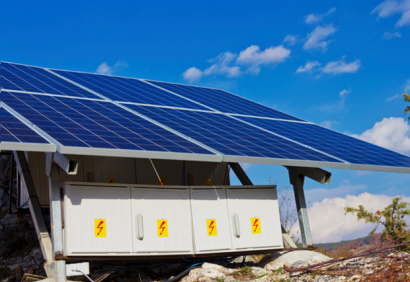A Look at The Benefits of Solar + Battery Storage Systems
 By Sam Polino, Fall 2016 Fellow
By Sam Polino, Fall 2016 Fellow
A major question from utilities and grid operators is how to manage the inherent variability of distributed solar resources. The addition of battery storage to large scale solar resources provides not only a more controllable generation source, but additional ancillary services to improve grid stability, reliability, and efficiency. Battery storage has become a cogent supplement to solar because of falling costs in the technology and the additional revenue streams from ancillary services.
Unlike traditional fossil fuel generation, solar is not dispatchable and production can fluctuate. Passing clouds and other weather events can create rapid swings in energy production distressing local grid equipment. More gradual variability in solar production caused by the seasons, inclement weather, and daily production ranges create capacity issues requiring accurate forecasting to predict energy production.
If a solar facility under performs, additional capacity reserves are required which can raise the clearing price of energy on wholesale markets. Conversely, if a system overgenerates, there may be a need for curtailment of the renewable energy facility. Curtailment in this case means that energy for a solar system is available, but would not be dispatched to the grid by the system operator. In times of low load and high solar generation, excess generation can occur. Curtailing renewable energy facilities is a worst case scenario because operational costs are essentially zero.
Fortunately, large scale solar arrays can now take advantage of battery storage systems to help mitigate variability and create additional revenue streams. The combination of falling battery prices as well as additional grid benefits batteries provide, allow large scale systems to be deployed economically. Depending on the electric power market and the local distribution/transmission conditions, batteries can provide frequency regulation, voltage support, instantaneous response rates, load shifting, and many other services. Designing the battery system to maximize utilization of the available grid services is key to creating the most value for solar plus battery projects.
To help address the variability issues, project design and energy allocation become very important considerations. When incorporating battery storage, some of the solar energy can be used to charge the battery which can then be used for smoothing the electricity output curve. One strategy to mitigate variability is to allocate more solar energy to the batteries to provide ramping support. Ramping occurs when there is significant power fluctuation over short periods of time. This sudden fluctuation in production can damage grid equipment. Incorporating batteries with solar allows major dips in production to be compensated with pre-stored energy. Conversely, solar energy can be stored in times of potential overgeneration. Additionally, this addition smooths the production curve for more accurate forecasting and operation. So although, the total amount of energy at any given time may be lower, large scale solar and storage facilities begin to provide more base-load energy to the grid that is dispatchable and predictable.
Figure 1. Solar plus storage providing ramping support
Source: Energy Storage Association
Battery storage also has the ability to better match load with real time demand, which comes in two forms: demand response and load shifting. Even on a perfectly sunny day, a solar PV system will only operate between certain hours. Equipping this same system with storage allows load to be dispatched when it is needed most, either at short sporadic periods throughout the day or during a longer period when the sun has set.
Batteries are perfectly suited to bid into demand response and help mitigate demand spikes because they respond quickly to utility signals. Typically, batteries have very fast discharge rates compared with conventional fossil fuel generators. Solar plus storage facilities also have the distinct advantage of not requiring excess grid energy to charge.
Similar to dispatching energy storage to moderate peak demand, batteries can be used to shift load to a later time completely. Typical peak demand periods for utilities are in the early evening, which creates challenges for solar since this does not align with their peak production. Charging large scale batteries with solar at on during the sunniest parts of the day and discharging that energy later in the evening can provide substantial demand mitigation for utilities.
Figure 2. Load shifting using battery storage
Source: Enphase
Not only are solar plus storage facilities able to match load with demand affectively, with no point source pollution and fast ramp rates, these systems can be placed much closer to high demand areas on the distribution system alleviating congestion and high peak energy prices. Large, centralized generation plants require substantial amounts of transmission equipment to distribute load to end consumers. In this path, congestion often occurs in areas with high demand and ill-equipped infrastructure. Too much load across power lines can cause serious damage, costing utilities money. Solar facilities equipped with storage can be sited much closer to high demand areas and therefor avoid congested transmission lines.
The time for investment in these facilities is now. Numerous pilot projects and full scale installations developed by utilities and private companies have shown that this combination works. The case for these projects will only continue to grow as developers and utilities realize the additional benefits storage systems provide. As solar energy continues to proliferate, battery storage will be a critical compliment in creating a more carbon-free, reliable, and resilient grid.
Sam Polino is a Fellow with the Clean Energy Leadership Institute and a Program Manager, Community Power Network (CPN).



